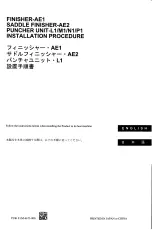
Functions
Leuze electronic
IPS 208i
19
4.1
Programs
There are four programs stored in the positioning sensor. The programs can be configured, e.g., to com-
pensate for the position difference between the loading position and unloading position of the high-bay stor-
age device.
Switch between or activate programs in the device as follows:
• Via the webConfig tool (see chapter 4.7 "Leuze webConfig tool")
• Via the SWI3 and SWI4 switching inputs (default setting)
• Via control buttons on the device
• Via an Ethernet online command
On delivery, all programs are optimized as follows:
• Working distance: 300 mm
• Hole diameter: 13 mm
• Offset X/Y: 0 mm
• Tol/- X/Y: 4 mm
• Marker tolerance: 15 %
4.2
Camera operating modes
The camera operating mode defines how the positioning sensor starts and ends a positioning operation.
4.2.1
Single trigger mode
In the "Single trigger mode" camera operating mode, the positioning sensor captures one image and at-
tempts to determine the actual position of the marker relative to the nominal position.
4.2.2
Reading gate control
Upon activation, the reading gate control opens a time window in the device for the positioning operation. In
this time window, the positioning sensor continuously determines the relative position and outputs the posi-
tion. The reading gate control must be deactivated again via the trigger signal.
The "Reading gate control" camera operating mode is activated upon shipment from the factory.
4.3
Quality score
The quality score is a measure of the quality of the found marker and refers to the shape factor, the scaling
factor and the contrast of the taught marker. The quality score is output in percent [%].
Limit values can be defined in the positioning sensor via the quality score:
• Limit value at which a switching output is set as a warning if the value is less than or exceeds the limit.
• Limit value at which images are transferred via Ethernet / interface (FTP).
• In addition, the determined quality score can be output via the interface.
4.4
Offset
Offset in the X/Y direction that is taken into account for the positioning, e.g., when moving goods in and out
of storage. Here, the offset shifts the nominal position relative to the center point of the region of interest.
The offset can be in the positive or negative direction.
NOTICE
You can set one offset value per program.
















































